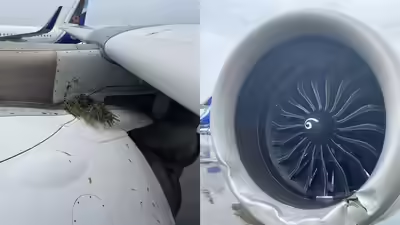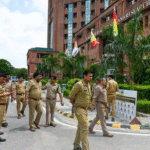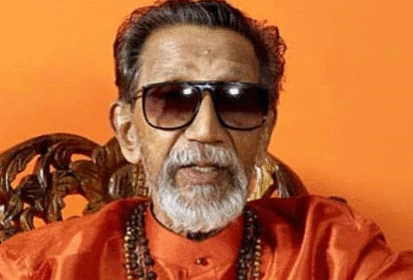The Incident That Nearly Shook a City — Mumbai’s Runway Scare Unfolded
An Ordinary Flight Turns Extraordinary
On July 20, 2025, Mumbai’s Chhatrapati Shivaji Maharaj International Airport—one of India’s busiest aviation hubs—was just beginning another ordinary day of controlled chaos. Flights touched down every few minutes, jet engines roared overhead, and ground staff executed their tasks with the usual clinical precision. However, as Air India Flight AI 681 from Kochi prepared for its final descent into Mumbai, what began as a routine landing swiftly spiraled into a situation that gripped air traffic control, airline authorities, and hundreds of anxious families across two cities.
The Airbus A320 aircraft carrying over 130 passengers and crew on board veered slightly off course while attempting to land on Runway 27. Although the deviation was minor in physical distance, the implications were anything but. Mumbai’s monsoon-drenched runways have witnessed close calls before, and every such incident is a chilling reminder of how quickly aviation safety margins can be tested. The pilots managed to stabilize the aircraft swiftly, thanks to a timely go-around initiated just seconds before touchdown. Moments later, the plane landed safely on a second attempt. No injuries were reported. But the close call left passengers shaken and sparked a broader inquiry into operational lapses.
Inside the Aircraft: Confusion, Then Calm
For the passengers onboard, the event began subtly—just a jolt, a wobble, an odd angle of descent that felt unfamiliar to frequent flyers. Some initially assumed turbulence or weather-related bumps were to blame. But as the aircraft aborted landing and powered back into the air with a sudden surge, tension gripped the cabin. Flight attendants, trained for such moments, moved swiftly and professionally, maintaining calm as they assured passengers that everything was under control.
Ranjitha Menon, a teacher returning to Mumbai after visiting her parents in Kochi, described the ordeal in an interview with local reporters:
“There was a moment when I thought the wheels had touched the runway, but then suddenly, we were climbing again. For a few seconds, it was quiet. Then people started murmuring, some started praying. I’ve flown dozens of times, but this was terrifying.”
The captain’s voice came over the intercom within moments: clear, firm, and composed. He explained that the aircraft had initiated a go-around due to “alignment inconsistency with the runway.” While that eased some nerves, the seriousness of the situation only became clear after landing.
Air India’s Response: Rapid, Yet Measured
Air India, now a part of the Tata Group following its privatization, was quick to release an official statement confirming the incident. The airline clarified that the cockpit crew, both highly experienced pilots, made a judgment call based on technical readings and real-time environmental inputs.
The spokesperson said:
“Flight AI 681 from Kochi to Mumbai encountered misalignment during final approach. Our pilots followed all standard operating procedures, initiated a go-around, and safely landed the aircraft. All passengers and crew are safe. We are coordinating with DGCA for a detailed review.”
Aviation experts lauded the pilots’ decision to go around—a maneuver that, while routine in professional flying circles, is still rare enough to draw attention. It’s a testament to the discipline and readiness of India’s cockpit crews, who undergo rigorous simulator-based training for precisely such scenarios.
DGCA Steps In: The Inquiry Begins
As expected, the Directorate General of Civil Aviation (DGCA) swung into action immediately after the incident was reported. Mumbai ATC submitted all audio logs, radar data, and communication transcripts for review. Preliminary investigation confirmed the aircraft had veered marginally off the centerline—potentially due to a combination of reduced visibility and wind shear.
DGCA officials stated that both cockpit voice recorders (CVR) and flight data recorders (FDR) had been secured for analysis. The focus of the probe, they said, would be to examine:
- Whether cockpit instrumentation malfunctioned
- If there was any lapse in air traffic control guidance
- Whether the aircraft was affected by sudden microbursts or shear winds
- Whether previous landing schedules were too tight to allow for safe margin
The investigation, officials promised, would be transparent, thorough, and geared toward improving runway approach protocols—not merely finding scapegoats.
Mumbai’s Monsoon & Its Aviation Challenges
This incident rekindled memories of past near-misses and tragedies that have occurred on India’s runways during the monsoon season. Mumbai’s airport, surrounded by residential structures and located in a dense urban area, poses unique challenges to landing aircraft—especially in turbulent weather.
Pilots often have to contend with:
- Sudden shifts in wind direction
- Slippery, rain-slicked runways
- Poor visibility due to heavy downpours
- Shorter turnaround times due to congested air traffic
Aviation analyst Capt. Ayan Bose noted:
“Mumbai is unforgiving. During monsoon, it demands 110% concentration from pilots. One misreading, and you’re in dangerous territory. The AI 681 incident could have gone very wrong if the pilots hesitated. But they didn’t—and that’s what saved the day.”
Media, Public & Misinformation
Within minutes of the incident, news media outlets flashed headlines of a “runway scare” and “narrow escape,” some even veering into sensational territory. Social media added fuel to the fire, with posts ranging from prayerful gratitude to conspiracy-laden theories about aging aircraft and Air India’s safety record.
While a healthy scrutiny of airline safety is always warranted, aviation experts urged for responsible reporting, especially during ongoing investigations. The pilots had, after all, acted decisively and safely. No mechanical failure had been reported. No protocols were breached.
Air safety specialist Priya Jaisingh cautioned:
“Creating panic where there was professionalism can discourage transparent reporting. Instead of vilifying go-arounds, we should normalize them as signs of good judgment.”
A Crisis Averted, But Questions Remain
What happened on board AI 681 may not have ended in tragedy, but it did shake public confidence—if only temporarily. It also raised important questions about aircraft monitoring systems, air traffic coordination, weather response systems, and the readiness of India’s civil aviation framework to handle such flashpoints.
As the investigation proceeds, this story continues to unfold not just as an aviation close call but as a window into how India’s aviation safety architecture is tested in real time.
For most passengers, the cockpit of an aircraft is an invisible realm—a place of quiet authority and absolute control. But for those in aviation, it is the frontline of decision-making. When Flight AI 681 began its descent toward Mumbai’s monsoon-soaked tarmac, the two pilots in the Airbus A320 cockpit had mere seconds to assess a rapidly evolving situation. What they did next would not only ensure the safety of 130+ passengers but also demonstrate the importance of aviation discipline in high-pressure moments.
According to internal Air India briefings shared with DGCA, the Captain of AI 681 was a veteran pilot with over 11,000 flying hours, including significant experience flying into high-density airports like Mumbai, Delhi, and Bengaluru. The First Officer, relatively younger but highly trained, had logged around 2,300 flying hours.
Their training kicked in precisely when it mattered. Upon noticing an unstable approach angle and reading inconsistent glide slope signals during the final descent, they initiated a go-around. The aircraft powered up, climbed to 3,000 feet, circled as instructed by ATC, and reattempted the landing from a more stable trajectory.
What Is a Go-Around? The Technical Explanation
A go-around is a standard maneuver pilots perform when a safe landing cannot be assured. It’s not a failure. In fact, it’s a sign of excellent judgment and a critical part of standard operating procedure across global aviation.
Common reasons for a go-around include:
- Unstable or unsafe approach
- Runway obstructions or aircraft not cleared in time
- Inconsistent instrument readings
- Bad visibility or sudden weather change
- Aircraft alignment deviation with the runway centerline
The International Civil Aviation Organization (ICAO) and DGCA both recommend a go-around if the aircraft’s final approach checklist isn’t fully satisfied by the time it reaches 1,000 feet above the airfield (in instrument conditions) or 500 feet (in clear weather). In this case, AI 681 was still descending below decision altitude when the crew noted a visual and technical misalignment.
A go-around is executed by:
- Applying full thrust
- Pitching the nose upward
- Retracting landing gear and flaps in sequence
- Communicating with ATC
- Climbing to the assigned altitude for a second attempt
Pilots Speak: Voices from the Aviation Trenches
Though the flight crew of AI 681 did not speak to the media directly, senior pilots within the airline shared insights on condition of anonymity.
One retired Air India pilot remarked:
“People outside aviation often think of go-arounds as emergencies. That’s not true. They are preventive actions—like hitting the brakes before a red light. These pilots made a textbook decision, and they should be applauded.”
Captain Sameer Chaturvedi, now an instructor at an aviation academy in Bengaluru, added:
“Flying into Mumbai during monsoon is like threading a needle while being sprayed with a garden hose. You’re dealing with ATC pressure, wet runways, low visibility, and frequent wind shifts. The cockpit is not a place for ego. It’s for judgment. That go-around probably saved lives.”
These testimonials reinforce a central theme: Safety is always the priority, even if it means deviating from the plan or drawing public attention.
Training Simulators: Where Pilots Prepare for Moments Like These
Pilots undergo simulator training every six months, mandated by DGCA and ICAO standards. These training modules include failure drills, crosswind landings, wind shear simulation, and go-around scenarios. The AI 681 pilots, as per Air India records, had completed their last simulator training just seven weeks before the incident.
Modern flight simulators are so advanced that they mimic not only physical dynamics but also emotional stress loads and cockpit communication under pressure. During training, pilots are evaluated not just on technical handling but also Crew Resource Management (CRM)—the art of clear, calm, and decisive teamwork under duress.
Air Traffic Control (ATC): A Critical Link in the Chain
While the pilots are the ones flying the plane, the Air Traffic Control tower is the eye in the sky. ATC cleared AI 681 to land on Runway 27. Moments before the incident, ATC had also cleared a preceding flight—an Indigo aircraft—for takeoff from the same runway.
Officials confirmed that there was no direct conflict between the two operations. However, due to heavy traffic and low visibility, AI 681’s flight crew may have encountered visual confusion during approach. Cross-checking radar logs and ATC voice recordings, investigators found no fault with ATC guidance. Still, the high volume of landings and tight schedules are under review.
Passenger Experience: Trust in the Unknown
While aviation experts talk shop in technical terms, for the average passenger, it all boils down to trust. When the aircraft jerked mid-descent and powered back into the sky, many onboard didn’t understand what had just occurred. Several passengers thought they had “missed” the runway or that the plane was malfunctioning.
After the safe landing, some passengers remained visibly anxious even as ground staff comforted them. Air India arranged on-ground counseling for elderly travelers and extended customer care services, including rescheduling missed connections.
In Perspective: What Could Have Gone Wrong
While AI 681 landed safely, any deviation from the expected trajectory—particularly in poor visibility—introduces risk. Mumbai’s narrow runway margins and high rainfall levels have been cited in earlier runway overrun incidents.
According to aviation risk models, even minor course corrections in the final phase of approach increase stress on landing gear, brake timing, and reverse thrust planning. A go-around allows these variables to be reset entirely.
Had the pilots chosen not to go around and attempted to “force” the landing, it could have resulted in:
- A runway excursion
- Hard landing resulting in structural damage
- Tailstrike due to incorrect nose angle
- Runway overrun, especially dangerous on wet surfaces
None of these occurred—because the pilots did not take that chance.
As the aviation industry races toward rapid expansion, especially in India, another invisible turbulence builds—one that exists not in the skies, but in scheduling spreadsheets, cockpit rosters, and overstretched infrastructure. The incident involving Air India Flight AI 681 on its approach to Mumbai wasn’t just about weather or pilot response—it was also a reminder of how systemic pressure and operational haste can set the stage for near-miss events.
In this part, we dissect the operational ecosystem that surrounds such incidents. We explore the impact of:
- Aggressive airline scheduling
- Pilot fatigue
- Airport congestion
- Runway and terminal infrastructure challenges
The Invisible Load: Airline Scheduling and On-Time Pressure
India is one of the fastest-growing aviation markets in the world. According to DGCA data, India saw over 15 lakh domestic flights in 2024, and the Mumbai–Delhi and Mumbai–Kochi corridors are among the busiest. The competition to offer maximum on-time performance (OTP) has created what insiders call “efficiency stress”.
For example, major carriers operate tight turnarounds—flights that land and depart again within 30–45 minutes. This doesn’t just affect ground crews and maintenance; it also compresses decision-making time for pilots.
Flight AI 681 was part of a tight evening slot at Mumbai’s Chhatrapati Shivaji Maharaj International Airport, where more than 950 aircraft movements are recorded daily. The urgency to land on first approach can sometimes be felt, even if not directly imposed.
A senior Air India pilot explained:
“There’s always pressure to maintain OTP, especially in Mumbai where even a five-minute delay can snowball into multiple missed connections. But a good pilot must know when to reject that pressure and fly by the book. These go-around events are an outcome of putting safety before schedule.”
Pilot Fatigue: The Hidden Threat Above the Clouds
Fatigue is an insidious threat in aviation. Unlike a visible failure, it doesn’t sound alarms or flash warnings. But it affects reaction time, decision-making clarity, and situational awareness.
Though the crew of AI 681 had legally rested before the flight, data from DGCA suggests that many pilots in India fly close to the regulatory maximum of 100 flight hours per month. Moreover, duty hours—which include time spent preparing for the flight, commuting, and undergoing checks—can often exceed 12–14 hours a day.
In July 2024, a confidential DGCA review of pilot rosters across four major airlines found that:
- 27% of pilots had back-to-back night and early-morning shifts within the same week
- 34% reported poor sleep due to overnight layovers in budget hotels near airports
- 19% admitted they’d experienced micro-sleep or fatigue-related alertness lapses while flying
The AI 681 incident has prompted renewed calls from pilot unions for realistic scheduling and mandatory rest buffers, especially when flying into challenging monsoon conditions.
Infrastructure Bottlenecks: A Tale of Two Runways
Mumbai operates two intersecting runways—Runway 09/27 and Runway 14/32—but they can’t be used simultaneously because of their design. This means the airport’s peak hour capacity is already maxed out.
Add to this the monsoon factor, and Mumbai becomes one of the most difficult airports in India to land at between June and September. Sudden wind shear, low cloud cover, wet tarmac, and poor visibility are frequent issues. Yet flight schedules remain full, and buffer time between landings is often reduced to under 2 minutes.
Mumbai has long requested the urgent need for a second airport—Navi Mumbai International Airport (NMIA), currently under construction and expected to open in 2026. Until then, pressure on Mumbai’s primary runway will continue to build.
An airport operations expert noted:
“Pilots are landing every 90 seconds. Add monsoon rain, and it’s like threading needles while blindfolded. AI 681’s near-deviation was partly due to this infrastructural bottleneck.”
Ground Reality: Communication and Cockpit–Control Room Disconnect
While cockpit discipline is critical, it must be supported by real-time communication from Air Traffic Control (ATC). In the case of AI 681, there was no procedural lapse from ATC, but aviation insiders often speak of a “communication disconnect” when traffic peaks.
Voice logs from Mumbai ATC show that during the 10-minute window surrounding the AI 681 go-around, four different aircraft were being coordinated simultaneously, including two incoming flights and one cargo departure. Human error at this scale is not uncommon, and while it didn’t contribute to this incident directly, it reflects a strained system.
Pilot unions have long advocated for:
- More radar controllers during peak hours
- Better coordination between Delhi and Mumbai FIRs
- AI-assisted tower alert systems that can flag potential conflicts
Lessons Unlearned? A Look Back at Similar Incidents
The AI 681 scare is not an isolated event. A look at recent aviation reports reveals similar runway and alignment scares:
- February 2023: An Indigo flight from Bengaluru overshot Runway 27 due to pilot misjudgment in heavy rain.
- September 2022: A Vistara flight veered slightly off centerline at Mumbai due to tailwind drift and wet conditions.
- October 2021: A SpiceJet aircraft suffered gear damage during a hard landing after a rushed descent in marginal visibility.
Each of these events ended without fatalities—but each was a warning flag. AI 681 has once again brought the spotlight back to the structural issues within Indian aviation safety systems.
DGCA’s Balancing Act: Regulation vs. Expansion
India’s Directorate General of Civil Aviation (DGCA) is under increasing scrutiny to strike a balance between safety enforcement and industry growth. With new private airlines, charter services, and regional connectivity schemes taking flight, the pressure on oversight mechanisms is intense.
Aviation experts warn that incidents like AI 681 serve as “stress tests” for DGCA’s inspection system. Immediate actions taken after this incident include:
- Ordering flight data recorder (FDR) and cockpit voice recorder (CVR) analysis
- Mandating monsoon-specific approach re-training for pilots flying into Mumbai, Goa, and Kolkata
- Reviewing the safety protocols and ATC staffing patterns during peak traffic hours
However, unless these responses evolve into long-term reforms, experts fear that the system may continue to operate on a reactive rather than preventive model.








